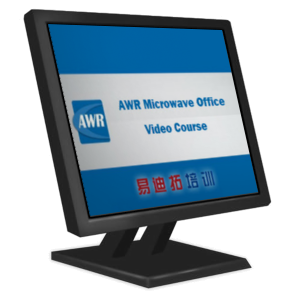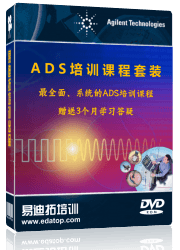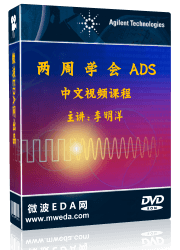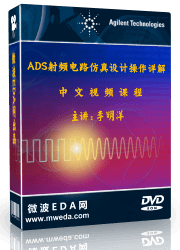
EM Simulation Fundamentals in Microwave Office
英文视频培训教程
英文原版讲解,讲解MWO中EM仿真器
如AXIEM、ANALYST的使用...
- 个人专业版
- U盾版
- 企业版
- 价格
- 99元
- 189元
- 269元
全长三个半小时视频课程,原版英文讲解。课程主要讲解和实例演示了AWR Microwave Office中电磁仿真器的使用操作和仿真设计应用,包括:AXIEM仿真设计和ANALYST仿真设计以及电磁仿真设计中的叠层设计。课程共3部分14小节,具体内容如下:
Lecture 1:EM Simulation Overview
This module overviews the electromagnetic (EM) simulation capabilities within AWR Microwave office.
Part 1:EM Simulators in Microwave Office
This part provides an overview of EM simulation, including types of EM simulators offered in Microwave Office. It describes the EMSight and AXIEM——MoM simulators, as well as the Analyst——FEM simulator, and explains how they work and their strengths and limitations.
Part 2: Project Creation and Definitions in EM simulation
This part looks at EM simulation in the Microwave Office flow and shows you how to create a project and use a library. The STACKUP blocks for global definitions are described, including material definitions and dielectric layers. Boundary settings and approximate open are also addressed.
Part 3: STACKUPs and EM layer mapping
This part explains STACKUPs and EM layer mapping, which must be set up correctly. You'll design an EM project using AXIEM simulator.
Part 4: EM Simulation using AXIEM simulator
In this part you'll learn about port settings in the AXIEM simulator, as well as the importance of deembedding, how to view the mesh, and how to generate S-parameters and compare them to a model.
Part 5: EM Simulation using EMSight simulator
runs through the same example from Part 4 using the EMSight simulator. You’ll create an EMSight project, insert a filter and ports, look at the mesh, and simulate.
Part 6: EM Simulation using Analyst FEM simulator
overviews Analyst finite element simulator and demonstrates how to set up the simulator for a simple project. Wave ports and meshing in Analyst are also explained and the final results are compared to the same project in EMSight and AXIEM simulators.
Lecture 2: Tips and Tricks for EM Simulation
This four-part video covers tips and tricks for setting up EM simulation more efficiently and effectively and shows you some advanced tools in Microwave Office software that make it easier to run EM simulations.
Part 1 - you’ll learn how to use the process creator tool to automate the process of creating a STACKUP block for an EM project and how to create and use a PDK library.
Part 2 - explains data sets, which are files where data is stored in AXIEM and Analyst EM simulators, and how to use a data set in a circuit schematic as a subcircuit.
Part 3 - you’ll learn how to change shape properties and layout using parameterization, as well as how to create EM-based models and run EM optimization. Setting up variable sweeping with an EM schematic is explained. You’ll use the variable tuner tool to both tune and optimize your EM model. You’ll also learn about an alternative method of creating shapes using preconfigured PCells that are controlled by parameters.
Part 4 - demonstrates an alternative way to create EM projects through EM extraction and an extraction flow example is demonstrated that shows how to do this..
Lecture 3: Analyst Overview
This five-part video demonstrates how to run Analyst——3D finite element method (FEM) EM simulator within Microwave Office software.
Part 1 - tells you some of the things for which the simulator is used and explains how a package is used, bond wires included, and simulation set up in the software. You’ll start a new project with a STACKUP and elements from libraries.
Part 2 - covers how to draw 3D cells and you’ll be walked through a coil example starting in Part 2 and continuing in Part 3.
Part 3 - You’ll check mesh connectivity and learn how to correct before simulating. The use of simulated data sets is demonstrated, and the results of the simulation are discussed.
Part 4 - shows some of the advanced features of Analyst, including how to use extrusion for 2D layout. An example is shown with upward extrusion. Part 5 describes how to extrude downward and addresses precedence rules for materials.
注:在线试看片段作了压缩处理,课程的实际效果比此处的在线演示片断更加清晰。您也可以下载该视频试看片段到本机播放【点击下载高清片段】。
 ADS是美国Agilent公司研发的微波射频电路、通信系统和MMIC/RFIC仿真设计软件,其功能强大、应用广泛,被国内高校、科研院所和大型IT公司广泛使用。掌握ADS,对于射频工程师来说无异于如虎添翼,可以有效提升自己的技术实力、提高工作效率。高级套装中包含易迪拓培训全10门ADS培训课程和教材,帮助学员全面深入学习掌握ADS的设计应用。【详细...】
ADS是美国Agilent公司研发的微波射频电路、通信系统和MMIC/RFIC仿真设计软件,其功能强大、应用广泛,被国内高校、科研院所和大型IT公司广泛使用。掌握ADS,对于射频工程师来说无异于如虎添翼,可以有效提升自己的技术实力、提高工作效率。高级套装中包含易迪拓培训全10门ADS培训课程和教材,帮助学员全面深入学习掌握ADS的设计应用。【详细...】 最新版ADS的入门和进阶培训课程,适合ADS2011 ~ ADS2014 版本ADS的学习。李明洋主讲,高清视频,直观易学。课程从基础讲起,通过设计实例,边操作边讲解,全面讲授了ADS在射频电路的仿真设计、微波平面电路的电磁仿真分析和RFIC设计的工程应用。通过该门课程的学习,可以帮助你快速上手掌握ADS的使用,并实现把ADS应用实际工作中去【详细...】
最新版ADS的入门和进阶培训课程,适合ADS2011 ~ ADS2014 版本ADS的学习。李明洋主讲,高清视频,直观易学。课程从基础讲起,通过设计实例,边操作边讲解,全面讲授了ADS在射频电路的仿真设计、微波平面电路的电磁仿真分析和RFIC设计的工程应用。通过该门课程的学习,可以帮助你快速上手掌握ADS的使用,并实现把ADS应用实际工作中去【详细...】 本课程基于新版的ADS软件,由李明洋老师讲授,讲解了ADS在微波射频模拟电路设计中的具体应用。课程为全程高清视频,边操作边讲解,直观易学,能够帮助你在最短的时间内学习掌握ADS的使用操作;课程同时结合工程设计实例来讲解,能够让你在学完之后,迅速地把ADS应用到微波射频电路的研发工作中去,真正学有所用,提升你的技术水平和工作效率【详细...】
本课程基于新版的ADS软件,由李明洋老师讲授,讲解了ADS在微波射频模拟电路设计中的具体应用。课程为全程高清视频,边操作边讲解,直观易学,能够帮助你在最短的时间内学习掌握ADS的使用操作;课程同时结合工程设计实例来讲解,能够让你在学完之后,迅速地把ADS应用到微波射频电路的研发工作中去,真正学有所用,提升你的技术水平和工作效率【详细...】 该门课程旨在帮助学员快速、全面、透彻地理解高低阻抗线微带滤波器的设计原理和设计步骤,帮助学员学会并掌握使用ADS软件仿真分析和优化设计微带线滤波器的实际操作,包括微带线滤波器的原理图电路的分析和优化、Layout版图结构的分析和设计优化,以及如何使用ADS DesignGuide来快速设计高低阻抗线微带滤波器【详细...】
该门课程旨在帮助学员快速、全面、透彻地理解高低阻抗线微带滤波器的设计原理和设计步骤,帮助学员学会并掌握使用ADS软件仿真分析和优化设计微带线滤波器的实际操作,包括微带线滤波器的原理图电路的分析和优化、Layout版图结构的分析和设计优化,以及如何使用ADS DesignGuide来快速设计高低阻抗线微带滤波器【详细...】
